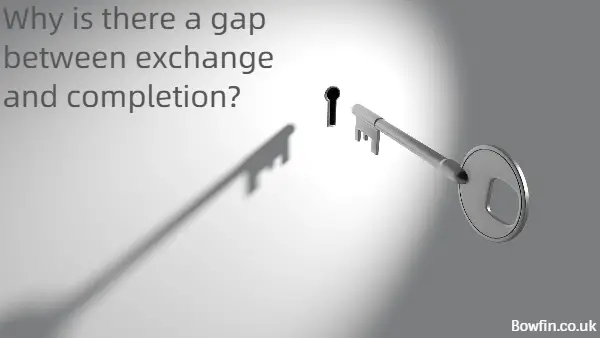Although there doesn’t have to be a gap between exchange and completion, as you can exchange and complete on the same day, there generally is a gap. Therefore, why is there a gap between exchange and completion? Let’s take a look…

Why there’s a gap between exchange and completion in brief:
The gap between exchange and completion is needed to allow both parties to prepare for their move. It allows time for packing and to change utilities. This gap is generally between one and two weeks, but it can be longer. This time also allows time for the solicitors to arrange the funds in readiness for completion.
Whilst there doesn’t have to be, there is usually a gap between the exchange of contracts and the completion date. The gap is usually between two and four weeks long.
This allows time for both parties (i.e. the buyer and the seller) to organise their personal belongings in readiness for moving. But also to arrange funds from mortgage lenders where appropriate.
How long between exchange of contracts and completion
Before I explain why there is a gap between exchange and completion, let’s explain the “gap” and a few terms around this concept.
When we talk about a “gap” between exchange and completion with regards to property transactions, we are referring to a period of time. The period of time in this context is generally between two to four weeks. Which is between the date that‘s referred to as the “exchange of contracts” and the second date that’s referred to as the “completion date”.
More Reading: What can go wrong between exchange and completion?
Before exchange of contracts can take place, the property needs to have “sold” first. In this context “sold” using estate agent’s speak is where the property has been “sold subject to contract”.
What happens on the day of exchange of contracts?
When contracts have been exchanged, both parties are legally bound to complete the transaction.
The term “sold subject to contract” refers to the “contract” that’s exchanged between the buyer and seller’s solicitor or conveyancer. It is this contract that facilitates the sale of all property in England and Wales. Scotland have a slightly different system.
More Reading: Do you need home insurance from exchange or completion?
The contract is drawn up by your conveyancer. On the day of exchange this signed contract will be exchanged with the conveyancer of the other side.
So for example, if you are the purchaser of the property, your conveyancer will exchange contracts with the seller’s conveyancer. And visa versa.
The contract will contain certain binding terms and conditions. The contract is bound by a signature from both parties. But more importantly it becomes binding as there’s a “passing of consideration“. Where in this context consideration is money.
Put this another way and in layman’s terms; there is a payment of money from the buyer to the seller. Although in reality, the money is lodged with your conveyancer. On exchange, this money is passed to the sellers solicitor or conveyancer.
More Reading: Can you exchange contracts without a completion date?
How much consideration must transfer on exchange of contracts?
For most exchange of contracts in England and Wales, consideration or money that changes hands is ten percent of the agreed selling price of he property. This is known as the deposit.
However, the deposit doesn’t have to be ten percent. This can be as low as £1 (i.e. minimum consideration) or as much as both parties (i.e. the seller and buyer) agree.
More Reading: Can a house sale fail after exchange? (What if either party pulls out?)
What is included in the contract of exchange?
The contract used in the exchange for property in England and Wales has a number of clauses that bind the buyer and seller.
One of the main clauses in the contract is the time frame or “gap” between exchange and completion.
How long after exchange of contracts is completion?
This “gap” or time frame can be anything from as little as zero days. In this case exchange and completion is on the same day. To the other extreme where the gap is more like a delay, which is generally referred to as a delayed completion.
But as already explained, most contracts of exchange will include two to four weeks between the date of exchange and the day of completion. But any time frame that exceeds this normal period or gap would be referred to as a delayed completion.
More Reading: What happens if a house burns down between exchange and completion?
What happens on the day of completion?
The day of completion is the agreed date that’s included in the contract. This date uses the date of exchange as a reference point. But then the gap period is added to this date to arrive at the future completion date.
Both the date on which contracts are exchanged and the completion date are always agreed up front before contracts are exchanged.
With the above information to hand, let’s take a look at the question posed at the start of this article:
Why is there a gap between exchange and completion?
The gap or time frame between exchange and completion is the for a few reasons. These include the following:
- The gap is to enable both parties to organise their belongings: Moving house after you’ve sold means you have to pack everything into boxes. This takes time. Up to the point until the sale is certain (i.e. contracts have been exchanged) there’s no point in doing this. Exchange of contracts provides for that certainty the sale has to go ahead.
- Arrange a date and time slot for a removals firm: Once contracts have exchanged the removals company booking can be firmed up. Where appropriate a deposit to the removal company will be paid.
- In addition to providing time for the parties to the house sale to organise their belongings, the gap between exchange and completion can also be used to arrange finances too: Whilst I’d not recommend you leave it until contracts have been exchanged before organising your mortgage, often times this does happen. Generally where this is the case, it is something that happens at an action. In an auction, when the hammer falls, this is the point at which contracts are exchanged. On the day of action you are usually required to pay ten percent of the “hammer price”. Where the hammer price is the final price bid at the point the auctioneer bangs his hammer.
- Transfer of utilities and other services: During the gap gives time to change or move utilities and services to the new address.
- Change of address notifications: A gap between exchange and completion allows you time to notify people and companies of your address change. But I always recommend using the Post Office redirection service.
More detail reference to an auction sale
The balance of funds of the auction’s “hammer price” is generally required to be paid within 30 days or four weeks.
As most people who buy at auction don’t know what the final hammer price will be, the finance or mortgage doesn’t get finalised until after the auction day. Most sensible property buyers will have an agreement in principle.
But not everyone does this, so they run the risk of defaulting on the purchase.
Why I don’t generally recommend this approach to most house buyers is this can become quite stressful. You are under a short time frame (unless you arrange for a delayed completion) to get things arranged.
After the buyer has “won” at auction, they are obliged to go ahead with the purchase. If for whatever reason the mortgage cannot be arranged, the buyer will be in default of the contract.
I hope this article has helped on why is there a gap between exchange and completion
If this article has helped about “why is there a gap between exchange and completion” please share it on your favourite social media site.
Also, if you have any questions, please feel free to comment below too. Alternatively, if you need more help, please feel free to contact us on our contact us page here. Or join the discussion and ask your question in the property forum.




